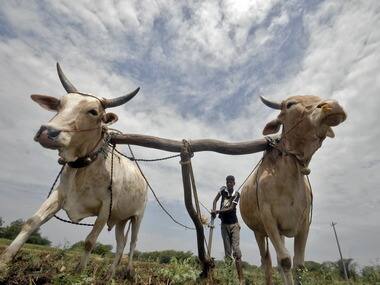For an economy caught amid galloping inflation, below par growth, tardy industrial progress and shrinking foreign investment, here’s some more bad news. Monsoon this year is expected to be below normal, said India’s Meteorological Department on Tuesday.
While it mentioned that decline in rainfall will be marginally lower than last year’s, any bigger shortfall could leave the economy in a tailspin with agricultural production going down. This, in turn, could bring down earnings and consumption in a large part of India and affect the macro-economic picture by slowing down industrial production further.
[caption id=“attachment_29177” align=“alignleft” width=“380” caption=“What is worrying about the prediction is the forecast for July, the key planting month for rice, sugar cane and corn. Krishnendu Halder/Reuters “]
 [/caption]
[/caption]
Government officials, however, played down concerns that lower rainfall could fan inflation and dampen growth. “There is no need to press the panic button, as June rains are still above normal,” said Shailesh Nayak, the top civil servant in the Ministry of Earth Sciences.
“There are chances the monsoon will pick up after July 15 once it covers the entire country,” said D Sivananda Pai, director at the state-run National Climate Centre. “Don’t go by the numbers, it is the distribution (of the rains) which we are still hoping to be good,” he added.
The weather office predicted 27 centimetres of rain in July compared with long-term average rainfall of 29 centimetres, and rains at 24 centimetres in August, when seeds start maturing, compared with long-term averages of 26 centimetres.
The department said this year’s monsoon rains would be 95% of the long-term average overall, down from its April forecast of 98% and just short of the 96-104% range which counts as normal monsoon.
What is worrying about the prediction is the forecast for July, the key planting month for rice, sugar cane and corn. The crops require proper rainfall between June and September. India had the driest monsoon season in over three decades in 2009 when rains were 23% below normal, which pushed it onto international markets to buy sugar, triggering prices to soar to record highs.
Eastern rice-growing regions have received the least rain so far but the country’s rice stocks are already overflowing after a bumper harvest last year. A normal monsoon this year could have encouraged the government to free up stocks in rice, sugar cane and cotton for exports, and helped boost consumer demand in the countryside to push economic growth in Asia’s third-largest economy.
Poor rainfall can trigger demand from farmers for higher rates for produce and waiver of loan repayment and electricity charges, hitting public finances . Lower farm output could add inflationary pressure on the economy. This would only compound concerns of Prime Minister Manmohan Singh, whose government is struggling to tackle a slowing economy along side criticism over its handling of a spate of corruption scandals and inability to push reforms.
Wholesale inflation currently stands at nine percent, roughly double the comfort level of the central bank, which has raised rates for the 10th time in just over a year on June 16.
Lower rainfall also crimps hydroelectric output and increases demand for diesel, whose subsidised prices are already inflating the government’s spending.
Reuters
)